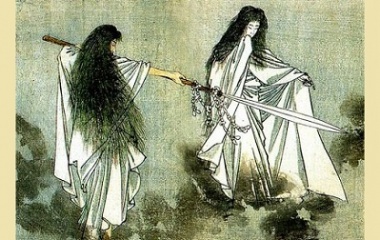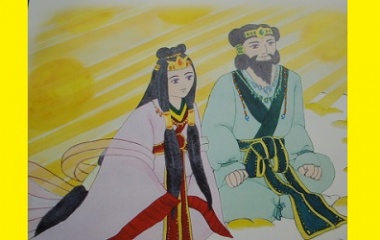- Pronunciation: ee-zah-na-gee
- Origin: Japanese Shinto Mythology
- Role: Creator god
- Children: Notably Amaterasu, Tsukuyomi and Susano-o
Introducing Izanagi
Every married couple has their ups and downs, but Izanagi and his wife Izanami (who is also his sister) are in a different league entirely.
Izanagi or “he who invites” is half of the divine duo responsible for the creation of Japan. Can you imagine a world without Nintendo or Toyotas? Well, you can thank Izanagi for the fact that you don’t have to.
The story of Izanagi and his wife is fundamental to the creation mythology of Japan and everything that happens in the stories to follow.
Depiction
Izanami is generally shown as a human man without any obvious divine or supernatural features. He is almost always shown with his partner Izanami. Izanagi is ethnically Japanese in appearance and wears traditional clothes.
Principal Myths of Izanagi
Izanagi is mainly known for his role in creating, well, everything in Japan, both natural and supernatural. He was a pretty busy guy, that’s for sure.
As Creator of Japan
Izanagi and Izanami were a pair of deities in Shinto mythology. They were not the first or only gods at the time of their birth, but were preceded by the first five gods, starting with Amenominakanushi. These gods were then followed by another seven generations. Izanagi and Izanami are therefore the seventh generation of those gods in the Japanese creation myth.
The other gods gave the pair a purpose, to create the first lands, and also a heavenly spear with which to accomplish this task.
At that time, the Earth only existed as a formless primordial ocean, without land. Standing on a floating heavenly bridge, Izanagi and Izanami dipped the jeweled spear into the waters, swirling them around. When they lifted the spear, the drops that fell down from its tip formed the first solid land. It was to this land that the two descended to continue the work they had been given by the gods in heaven: to create land and the gods (or kami) that would dwell there.
After living on this land for some time, the brother and sister wished to be married and have children. They built a palace and performed a marriage ritual, but because Izanami spoke before Izanagi during the ceremony, it was not properly completed.
On the first two occasions Izanami gave birth, the children were deformed. Instead of giving birth to gods, the couple produced devils named Hiruko and Awashima. Izanagi put them on a boat and sent them out to sea.
The other gods suggested it was because the couple had messed up their marriage ceremony that the devils were born. After performing a second marriage ceremony, and doing it correctly this time, the couple began to have children. These children became the gods that walked the Earth.
The chain of islands that make up Japan were then born from Izanagi and his wife. Over the course of their marriage, they had many divine children who became deities, islands, mountains and other natural features of Japan.
Everything went well until Izanami gave birth to the fire god Kagu-Tsuchi. The burns that Izanami suffered caused her death and her soul descended to the underworld, but not before she created more gods as she lay dying. Izanagi’s tears of grief created yet more gods. Really, this was a very fruitful union, all things considered.
Izanagi Visits the Underworld
Izanagi did not take the death of his wife well. He headed for the underworld with the idea that he would bring her back. When he met her in the shadows, she let him know that she could never leave the underworld because she’d already eaten the food. Izanami asked him not to look upon her, but he refused, creating a light to see her clearly.
What he saw was a monstrous image: Izanami was rotting and corpse-like. Her shame and embarrassment at being seen soon turned to anger and she set hag spirits, thunder gods and an army of underworld warriors to chase Izanagi.
Izanagi fled for his life, nearly being caught a few times. As he escaped the underworld, he blocked the entrance to the world permanently. Izanami spoke to him through the barrier and they decided to finally get a divorce.
It wasn’t an amicable separation, however. Izanami threatened Izanagi with the deaths of 1000 of his people every day. Izanagi then countered that he would create 1500 new people every day. This marked the beginning of the cycle of life and death.
The Birth of Amaterasu
His trip to the underworld and being so close to the dead had made Izanagi feel more than a little unclean, so the first order of business was to purify himself in water. In what was sure to have been a surprise to him, he gave birth to three gods as he washed his left eye, right eye and nose. These gods were Amaterasu, Tsukiyomi and Susano-o: the sun god, moon god and sea god, respectively.
Although these three gods are very important in Shinto, it’s Amaterasu the sun god who holds a particularly special place, just as sun gods do in many different cultures.
Literature
Stories about Izanagi are found in two primary texts. One of these is the Kojiki, which is the oldest Japanese chronicle still in existence. It dates from approximately 711 CE and contains much of the foundational mythology of Japan. The other is the Nihon Shoki, the second oldest book, dating from 720 CE. This second book contains much more detail about the myths of Japan than the Kojiki.
In Modern Culture
Izanagi and the stories he features in are still told to this day. The various gods of Shinto are also often referred to or referenced in television shows, video games and movies.
For example, Izanagi is one of the titular Personas in the massively popular video game Persona 4.
Myths from the Kojiki and Nihon Shoki are enacted in traditional theater shows and are popular attractions. Traditional artwork showing Izanagi and the creation of Japan is readily available and much-loved.
Shinto is still the dominant religion in Japan, followed by Buddhism, so the stories of Izanami, his wife and many, many children remain relevant to the daily lives of Japanese people to this very day. There are many rituals and festivals in Japan that keep gods like Izanagi alive in the minds of the Japanese people.










